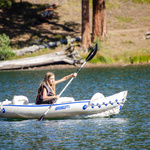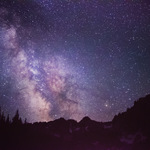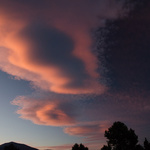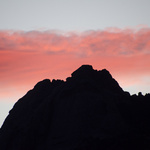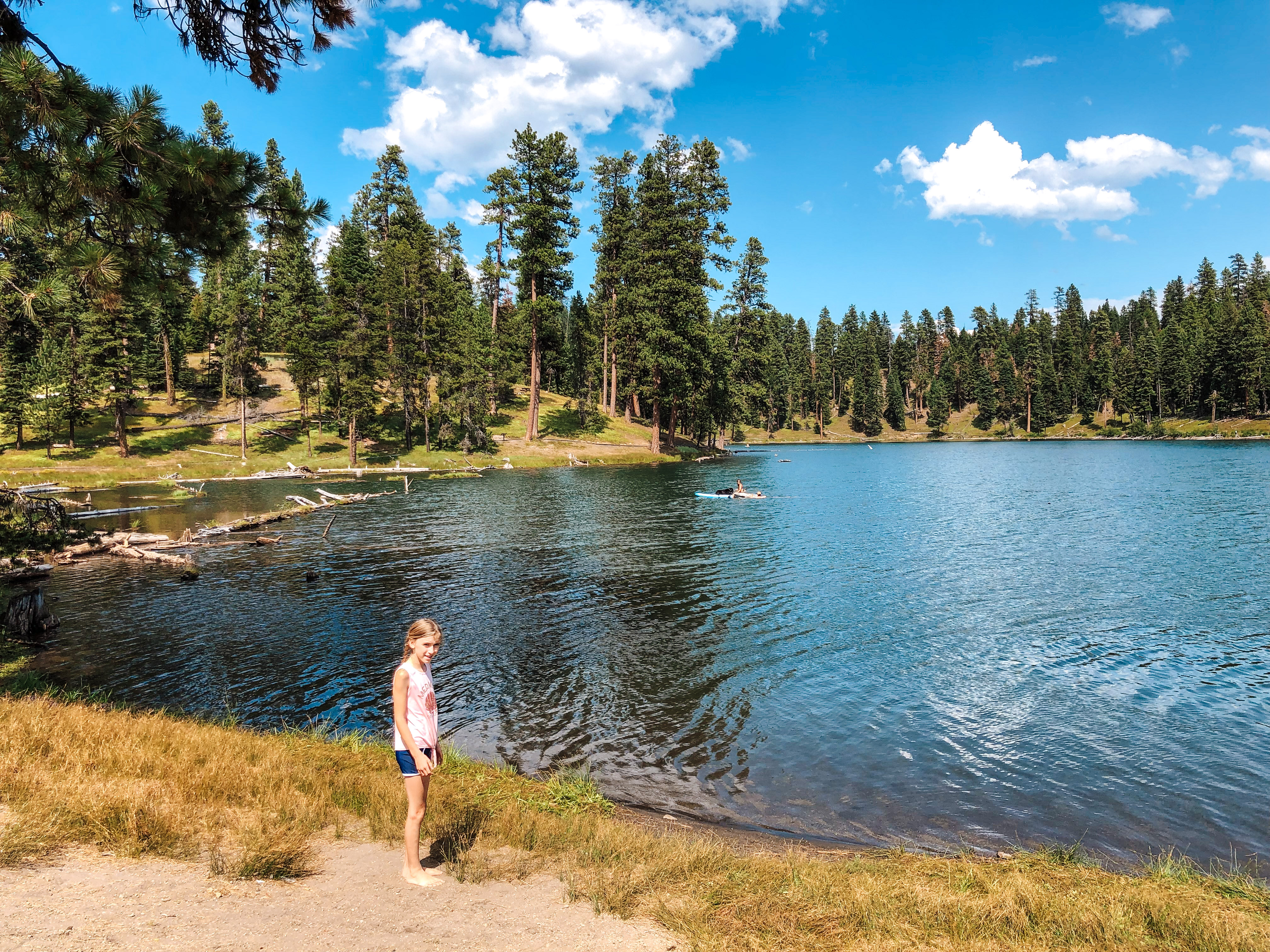
Oregon Road Trip: 3 Day Recommended Itinerary
#PNW . 3-Day Itineraries . Itineraries . Oregon . Outdoor Recreation . Tent Camping . Trailer Camping . Travel
Contents of this Post
The Best Oregon Road Trip: Camping in Eastern Oregon
Thinking of planning your own Oregon Road Trip? Our recommended Oregon road trip itinerary includes full-day activities for each of the three days. Click on any of the days in our itinerary contents list below to jump to that part of the itinerary. Plan extra time for travel to and from Eastern Oregon. We drove about 4 hours each way from Boise, and still managed to pack all of this in to 3 days!
I grew up in Oregon, and I keep coming back. And now I’m sharing my favorite spots for camping, hiking, and exploring this beautiful state. We just got back from a 3-day road trip to Prairie City, John Day, Clyde Holliday State Park, and Magone Lake. We also toured one of Eastern Oregon’s best-kept secrets, the Kam Wah Chung & Company historical site and interpretive center. Keep reading for highlights and recommendations.

Planning a trip soon? Click on either of our banner links here to get discounted airline tickets and nearby hotel rooms! Our site is partly supported by affiliate partnerships; your purchases through our affiliate links help support our site and the development of even more great content!
Day 1 of the Oregon Road Trip: Clyde Holliday State Park and the John Day River
- Camp in the shade along the John Day River
- Catch Crawdads (Crayfish) in the John Day River
- Build a Fire and Sleep in a Tipi
Day 2 of the Oregon Road Trip: Kam Wah Chung & Co. Historical Site and Magone Lake
- Take a guided tour of the Kam Wah Chung & Co. Historical Site
- Kayak or Boat Magone Lake
- Walk Around Magone Lake
- Relax on the Beach at Magone Lake
Day 3 of the Oregon Road Trip: Prairie City and Rural Oregon Sightseeing
- Walk Through Historical Prairie City, Oregon
- Visit Prairie City Antiques, High-Quality Collectors’ Shops
- Drive Through Rural Unity and Vail, Oregon
Day 1 of the Oregon Road Trip: Clyde Holliday State Park and the John Day River
Best Camping in Oregon: Camp in the shade along the John Day River
Clyde Holliday is one of our favorite Oregon State Parks because it is one of the shadiest spots along the John Day River. The camp host and staff work hard to make sure the grounds are well-watered and green, despite heavy use of the campground and day-use area during the hot summer months. The campground sits along Highway 26 at the banks of the John Day River. A walking path leads along the river, where you can dip your toes and watch hundreds of small-to-medium crayfish swim out of the way.

Pro Tips for Clyde Holiday State Park:
- Clyde Holliday does not take advance reservations for its 31 tent- and trailer campsites. If you can arrive before noon or during the work week, you will most likely be able to secure a site.
- Sites 11 and 13 are our picks for the best combination of shade, river access, and distance from the highway and restroom facilities. There really are no bad sites, but these are our two favorites.
- You can reserve either of the two large tipis (or teepees) online through the Oregon State Parks’ Reserve America website, as early as 9 months before your visit.
- Visit the Oregon State Parks site for Clyde Holliday for updates and information about the park.
- Bring a towel! Between the river nearby and the clean, comfortable showers and bathrooms at the center of the campground, you’ll find all the comforts of home at Clyde Holliday State Park.
- The park sells firewood for $5 per two cubic feet. This is a great deal compared with bundles you find at many supermarkets and stores around the state. And don’t worry; if you’re not sure how much 2 cubic feet is, the park provides a handy rolling cart built to that size that you can simply fill and roll to your site.
- If no sites are available as walk-up sites, the park does have a group camp/overflow area, so be sure to ask about that area if all the sites are full.
- Ask the camp host about area attractions, like those we share here and others. We didn’t make it up to the Strawberry Lakes this trip, but there are many day hikes and other activities close by. John Day is building its brand new outdoor water park, skate park, and playground, for example. And you’ll learn where to get Dayville’s famous pies and other local favorites.

Best Camping in Oregon: Catch Crawdads (Crayfish) in the John Day River
There’s no shortage of crayfish in the John Day River (what we grew up near the Deschutes River in Bend, Oregon, calling crawdads). At first, the girls were a little skittish as they quickly darted underwater and swam away. But when they realized the crawdads wouldn’t attack, the girls became more brave, picking a few up to examine them before letting them go again. The best camping in Oregon must have some good catch-and-release, whether it’s trout or crayfish. And Clyde Holliday doesn’t disappoint in that regard.


Best Camping in Oregon: Build a Fire and Sleep in a Tipi
The State Park not only manages 31 campsites; it also rents out two large tipis for overnight camping, complete with secure entrances and large mattresses. You can actually reserve the tipis (also spelled “teepees”) online at the Oregon State Parks’ Reserve America site. The mattresses look like a combination of queen and full-size beds, and have a thick vinyl exterior, so you can throw your sleeping bag or bedding right on top. The tipis get pretty hot when hit by direct sun, but they are designed to allow an upward draft to cool off at night.



Day 2 of the Oregon Road Trip: Kam Wah Chung & Co. Historical Site and Magone Lake

Tour the Best Preserved Historical Site of Chinese Immigrants in the 18th and 19th Centuries
Interesting Facts About Oregon: One of the most significant and interesting historical sites in Oregon sits near John Day, Oregon’s Main Street. Chinese immigrants Ing Hay and Lung On bought Kam Wah Chung & Company in 1880. They turned the dry goods store into a successful, 50-year partnership, providing medical care, dried goods, lodging, entertainment, writing and translation services, and other important services to both the Chinese and non-Chinese communities. The interior sat mostly undisturbed for decades after the owners departed, a time capsule opened in the 1970s and preserved as a museum. Today, visitors can observe artifacts left by Ing Hay and Lung On throughout the carefully preserved site.

Interesting Oregon Fact #1: Kam Wah Chung & Co. is the Greatest Surviving Collection of Materials Documenting Chinese Immigrant Lives in the American West
The 2005 National Historic Landmark Report noted that this collection is the best of its kind. “The Kam Wah Chung Company building and its contents are the greatest single surviving group of materials known dating from the late 19th and early 20th centuries that reflect the lives of the Chinese immigrants in the American West.” The two owners, Lung On and Ing Hay, created a partnership that lasted more than half a century. Lung On developed business ventures and connected with community members throughout Eastern Oregon and beyond. Ing Hay, much more quiet and reserved, provided medical care and candy treats. He maintained his practice inside the Kam Wah Chung & Co. building.

Interesting Oregon Fact #2: John Day’s Chinese Settlement Became the Third Largest “Chinatown” in the United States
In the 1800s, men from Guangdong or Canton Province immigrated to the United States in search of work. Many settled in Portland, Oregon, and San Francisco, California. However, thousands also found their way to Eastern Oregon and John Day’s Chinese settlement. After the discovery of gold in 1861 and 1862 in Auburn and Canyon City, more than 1,000 immigrants joined the gold rush. The Chinese settlement in John Day peaked around 2,000 residents, making it the third largest in the United States. Only Portland and San Francisco had larger settlements at that time.

Interesting Oregon Fact #3: The Chinese Exclusion Act Impacted Oregon and Immigrants in John Day, Too
The Chinese Exclusion Act of 1882 followed more than 600 anti-Chinese state laws around the United States. Thus, the Act prevented any further Chinese immigration. It also barred Chinese immigrants from citizenship, and made it illegal for the Chinese to own land. Fortunately for Ing Hay and Lung On, when they purchased Kam Wah Chung & Co., they executed a 99-year lease. They also made other provisions to secure their interests in the company, despite the recent federal legislation.

Interesting Oregon Fact #4: Kam Wah Chung & Co. Grew into Multiple Businesses, including Eastern Oregon’s First Car Dealership
Ing Hay (“Doc Hay”) and Lung On developed a thriving business and entrepreneurial enterprise with Kam Wah Chung & Company.
Doc Hay entered the U.S. with his family from Canada, first working in Walla Walla, Washington before settling in John Day, Oregon. A trained “pulsologist,” Doc Hay brought an ancient Chinese method of diagnosis and treatment with him to Eastern Oregon. He used his vast collection of more than 500 herbs and animal parts to brew teas and other medicinal poultices for patients.
Lung On arrived in John Day from San Francisco. He spoke and wrote multiple languages, including Mandarin, English, and classical Chinese. Lung On developed various business ventures, including the town’s first car dealership after he visited Portland and saw an automobile for the first time. He approached the owner and offered to buy the vehicle, beginning a new venture that would add value and new businesses to the region.
Next Up: Kayak or Boat Magone Lake
When we stopped by the bank in John Day, several people suggested we visit Magone Lake. Magone Lake is a short 30-40 minute drive from Clyde Holliday State Park, mostly because of the 13 or so miles on a gravel forest service access road. The road is wide and well-maintained, but it just takes longer to drive on the winding, gravel road. But it’s worth the drive. Magone Lake sits above the surrounding high desert, among higher elevation pine forests. The lake is just 10 miles from John Day, and you can get there either through John Day or Mount Vernon. Click here to view the forest service site, or check out the Magone Lake campground information and reservations at its Reserve America listing.

Magone Lake is just 30 acres, so you can easily paddle your way across and around the lake in no time at all. The lake has numerous stumps that protrude from the water, the most notable right in the center of the lake. In fact, regular visitors have notched the log to create a sort of jumping platform if you have the courage to take the plunge! Other stumps line the banks of the lake in shallower water. There’s also a boat ramp if you bring your fishing boat or other towable watercraft.


Walk Around Magone Lake
Forget to bring your own raft, kayak, or canoe? Don’t worry; there are plenty of other activities to keep you busy for hours at Magone Lake. For one, a maintained walking path encircles the lake, and there’s even an accessible section with paving, interpretive signs, and a large viewing platform that extends out over the lake.


Relax on the Beach at Magone Lake
If you’re not interested in kayaking, boating, swimming, or walking around Magone Lake, there’s always one other option: sit on the beach and do nothing! Magone Lake has numerous access points and beaches that dot the shore, in between tree stumps and rock outcroppings. The best beach sits just below the main parking area and group picnic structure. The beach extends around the main point, overlooking most of the lake from a central location. Bring your towels and sunscreen, because this is a spot you won’t want to leave!

Day 3 of the Oregon Road Trip: Prairie City and Rural Oregon Sightseeing
Walk Through Historical Prairie City, Oregon
We’ve visited a number of rural, Western towns lately (like West Yellowstone, Montana, and others). Prairie City is, by far, our favorite. The town sits between John Day and the mountain passes that lead up through the Malheur National Forest and then the Wallowa-Witman National Forest before descending to the fertile agricultural valleys of Eastern Oregon and Southwestern Idaho. Prairie City has remained small but thriving, unlike too many other small towns dotting the Western states.

The drive through town along the highway passes a vibrant downtown core with restaurants, shops, and a fantastic playground a block away, near the forest service offices and other official buildings. The food is great, the antiques are collectible, and there’s enough charm in Prairie City to go around. If you’re not in a hurry, set up camp nearby and take some time to wander the streets and check out the Prairie City Antiques shops (both of them) before you go. And swap a book or two at the Little Free Library, just outside of town to the East.


Visit Prairie City Antiques, High-Quality Collectors’ Shops
If we’ve been to a lot of rural, Western towns, we’ve also been to a lot of antique shops. Small town antique shops can be hit-or-miss, whether it’s Eastern Oregon or the East Coast of New Zealand. Prairie City’s antique shop (and its warehouse displays for sale down the street) is one of the best we’ve ever seen. The collection is carefully selected and curated, with a focus on collectible, high-quality pieces. And the prices are very reasonable; a 3-foot high hand-crank phonograph with speakers and turntable was priced at just $325, for instance. If you don’t stop for food or gas or a free book exchange, stop in Prairie City just for the antiques. Click here to view their website and check their hours and current items for sale.


Drive Through Rural Unity and Vail, Oregon
We drove about four hours from Boise to Clyde Holliday State Park, driving through Vail, Unity, and Prairie City, Oregon both ways. But we’ve been driving this route for years, visiting family in Central Oregon during the holidays and summers ever since I moved to Idaho for college years ago. Highway 20 through Juntura and Burns is faster, but you can’t beat the scenery of the Blue Mountains and the charming rural towns that line the route. Stop in Unity for gas and a bite to eat, and don’t miss the Oregon History display documenting the Historic Eldorado Ditch in Unity and the stories of the armed disputes over water and water rights in the area. The Malheur National Forest and Wallowa-Witman National Forest separate Prairie City from Unity and Vail to the East. And it’s a beautiful drive between them all.


I’ve been driving this road for 20+ years, and I’ve always thought the barns along this route are a slice of Americana. From big, red barns to sleek, functional stables, Highway 26 from Prairie City to Prineville has a little bit of everything rural and agricultural. (If you’re a big a fan of rural scenes, click here to check out our free, downloadable stock images of barns and other rural landscapes).




